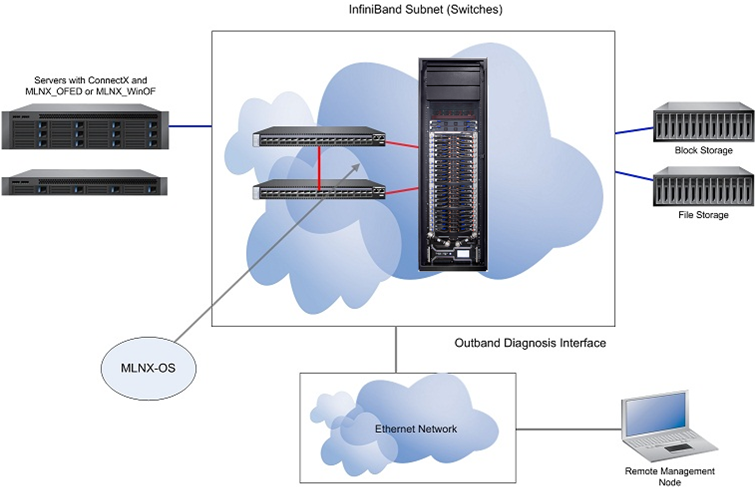Overview
These pages are intended for network administrators who are responsible for configuring and managing NVIDIA’s switch platforms.
The following table lists the documents referenced in this User Manual.
Document Name | Description |
System Hardware User Manual | This document contains hardware descriptions, LED assignments, and hardware specifications, among other things |
Switch Product Release Notes | Please look up the relevant switch system/series release note file |
Term | Description |
AAA | Authentication, Authorization, and Accounting:
|
ARP | Address Resolution Protocol. A protocol that translates IP addresses into MAC addresses for communication over a local area network (LAN). |
CLI | Command Line Interface. A user interface in which you type commands at the prompt. |
DCBX | Domain Name System. A hierarchical naming system for devices in a computer network. |
DHCP | The Dynamic Host Configuration Protocol (DHCP) is an automatic configuration protocol used on IP networks. |
Modular switch | A high density InfiniBand chassis switch system. |
DNS | Domain Name System. A hierarchical naming system for devices in a computer network. |
Fabric management | The use of a set of tools (APIs) to configure, discover, and manage and a group of devices organized as a connected fabric. |
FTP/TFTP/sFTP | File Transfer Protocol (FTP) is a standard network protocol used to transfer files from one host to another over a TCP-based network, such as the Internet. |
Gateway | A network node that interfaces with both InfiniBand and Ethernet, using different network protocols. |
GID | Global Identifier. A 128-bit number used to identify a Port on a network adapter (see below), a port on a Router, or a Multicast Group. |
GUID | Globally Unique Identifier. A 64-bit number that uniquely identifies a device or component in a subnet. |
HA | High Availability. A system design protocol that provides redundancy of system components, thus enables overcoming single or multiple failures in minimal downtime. |
Host | A computer platform executing an Operating System which may control one or more network adapters. |
IB | InfiniBand |
LID | Local Identifier. A 16 bit address assigned to end nodes by the subnet manager. Each LID is unique within its subnet. |
LLDP | Link Layer Discovery Protocol. A vendor neutral link layer protocol used by network devices to advertise their identify, capabilities and for neighbor discovery. |
MAC | A Media Access Control address (MAC address) is a unique identifier assigned to network interfaces for communications on the physical network segment. MAC addresses are used for numerous network technologies and most IEEE 802 network technologies including Ethernet. |
MTU | Maximum Transfer Unit. The maximum size of a packet payload (not including headers) that can be sent /received from a port. |
Network Adapter | A hardware device that allows for communication between computers in a network. |
RADIUS | Remote Authentication Dial In User Service. A networking protocol that enables AAA centralized management for computers to connect and use a network service. |
RDMA | Remote Direct Memory Access. Accessing memory in a remote side without involvement of the remote CPU. |
SA | Subnet Administrator (SA) is the interface for querying and manipulating subnet management data. |
SCP | Secure Copy or SCP is a means of securely transferring computer files between a local and a remote host or between two remote hosts. It is based on the Secure Shell (SSH) protocol. |
SM | Subnet Manager. An entity that configures and manages the subnet, discovers the network topology, assign LIDs, determines the routing schemes and sets the routing tables. There is only one master SM and possible several slaves (Standby mode) at a given time. The SM administers switch routing tables thereby establishing paths through the fabric. |
SNMP | Simple Network Management Protocol. A network protocol for the management of a network and the monitoring of network devices and their functions. |
NTP | Network Time Protocol. A protocol for synchronizing computer clocks in a network. |
SSH | Secure Shell. A protocol (program) for securely logging in to and running programs on remote machines across a network. The program authenticates access to the remote machine and encrypts the transferred information through the connection. |
syslog | A standard for forwarding log messages in an IP network. |
TACACS+ | Terminal Access Controller Access-Control System Plus. A networking protocol that enables access to a network of devices via one or more centralized servers. TACACS+ provides separate AAA services. |
Feature | Detail |
Software management |
|
File management |
|
Logging |
|
Management interface |
|
Chassis management |
|
Network management interfaces |
|
Security |
|
Date and time |
|
Cables & transceivers |
|
Unbreakable links |
|

Feature | Detail |
Subnet manager |
|